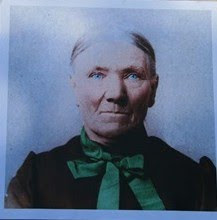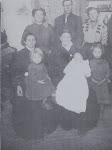 |
| Captain Edmund Ellsworth First Handcart Company |
Finally, on June 9, the great handcart experiment began. With buoyant spirits and an enthusiastic send off, they set out across Iowa. There were about 280 people, including a man age 71 and the youthful Birmingham Brass Band. Each traveler was allowed only 17 pounds of luggage (clothing, bedding and utensils). If they had additional baggage, they had to pay for it to be transported later by ox-trains. Those who could not afford the freight costs sold what they could and simply abandoned the rest. The wagon assigned to the handcart company hauled supplies. There was a tent for each 20 people. The first day the emigrants traveled only four miles. Then, they had to remain idle for a day while the men searched for strayed oxen. Animals recovered, the company again set out, only to have two of the poorly constructed handcarts break down (repairing carts became a frequent necessity). On June 12 a young boy died soon to be followed by the deaths of other children and adults. The company passed through Newton, Iowa, and near Fort Des Moines on June 23. Repeatedly wracked by wind and rainstorms, on July 8 they arrived at and ferried across the Missouri River. They then went to the campground at Florence, Nebraska Territory, where they spent 10 days repairing carts and getting ready to continue.
Initially their progress had been slow, but the pace increased. They averaged seven miles a day the first week, almost 13 miles per day the next week and hit their stride before reaching Florence at which time they were covering up to 20 miles a day. Hunger, fatigue, fainting, and illness were commonplace. Daily food rations for adults were between one-half and one pound of flour, plus two ounces of rice, three ounces of sugar, and one-half pound of bacon per week; children got less. At Kanesville, Iowa, they purchased two more wagons and additional livestock. A few members of the company dropped out along the way while others decided to stay in Florence. At Florence 30 Italian Saints joined the company. Much of the time was spent making major repairs to the carts, which had been made of green lumber with no skeins on the axles and no boxes in the hubs. To minimize wear, workmen installed tin boxes in the hubs and thick iron hoops around the axles.
Finally ready, they left Florence on July 20 with 55 handcarts, each laden with up to 500 hundred pounds of supplies and luggage). There were also three wagons, three mules, one horse, and six yoke of oxen. They ferried across the Elkhorn River and followed the Loup Fork River for two days before crossing it via a rickety ferry-boat (after that, most streams had to be forded). Prairie thunderstorms were terrifying; on July 26 lightning killed one man, knocked down two other adults, and burned a boy. The road was sometimes muddy, often sandy and hilly. The men carried the carts across Prairie Creek (even the wagons had difficulty crossing); later they crossed Wood River on a good bridge. When an ox died, they replaced it with a wild steer that was providentially supplied. Once they waited more than an hour for a buffalo herd to cross the road. Hunters killed some of the buffalo for food. Occasionally they slaughtered one of their beef cattle. On the plains, they cooked with buffalo chips and once drank water from a buffalo wallow, which caused widespread diarrhea in the camp. On August 8, a man turned up missing and was not found until the next day, five miles ahead of the company.
After traveling on the north side of the Platte, they forded it at Fort Laramie on August 26. They then crossed the North Platte to the north side near present-day Orin, Wyoming, and recrossed it back to the south side above Douglas. On August 31 they reached Deer Creek (near present-day Glenrock, Wyoming), where they met five supply wagons that had been sent from the valley to assist them. On September 3 they forded the Platte for the last time below the Upper Crossing, at present-day Casper, Wyoming. The next day the weather turned cold. That day and the next it rained and snowed, keeping the company in camp and making it impossible to start fires. Then to make matters worse, 24 head of cattle strayed, so the men spent a day recovering them. The company reached Devil's Gate and passed by the old Fort Seminoe trading post on September 8. On September 11 they took the Seminoe Cutoff, an alternate route that tracked south of Rocky Ridge, bypassing it and four crossings of the Sweetwater.
Ellsworth had taken this cut-off in 1854 when traveling to serve a mission in England. After traveling nearly night and day to overtake them, Daniel McArthur's handcart company pulled in at almost 11:00 p.m. and camped beside Ellsworth's company at present-day Alkali Creek on the cutoff. On September 13 at Pacific Springs they found John Banks's wagon train; it had left Florence 10 days ahead of them. Handcarts regularly arrived in camp long before accompanying wagons, and handcart captains often complained that wagons slowed them down.
On September 18 they forded Green River. An eastbound missionary company saw them there as they were descending the ridge to the river. It was an impressive sight and they got out of their wagons and formed a line for the oncoming handcarts to pass through, cheering them with a hosanna shout. Three days later Ellsworth's company camped at Fort Bridger. Even through the mountains, where they were beset by cold and thunderstorms, they averaged over 20 miles per day. Proving their fitness, they climbed up and over Big Mountain in less than three hours. They camped at the foot of Little Mountain and the next day, September 26, entered the Salt Lake Valley. There, a welcoming committee headed by Brigham Young met them and treated them to a melon party. While Ellsworth's group feasted on melons, McArthur's handcart company pulled up and the two handcart groups joined the First Presidency, the Nauvoo Brass Band, H. B. Clawson's company of lancers, and many local citizens in a grand parade into the city. Hundreds of citizens joined them and spectators cheered.
Sixteen persons had died. Some had questioned the ability of women and children to travel by handcart. Numerous children walked the whole way and Ellsworth said that women withstood the rigors of the trail better than men of comparable age.















Fuller Family March 27, 2019 at 12:37pm
ReplyDeleteWe are related to Selina Marshall thru my grandmother Delilah Pike. We have attened the reunions until you went to the internet, then somehow we got lost and missed the one held in Salt Lake, We are trying to get back in touch with you. My new email address is g_macookie8@yahoo.com, my name is Doris Ashworth